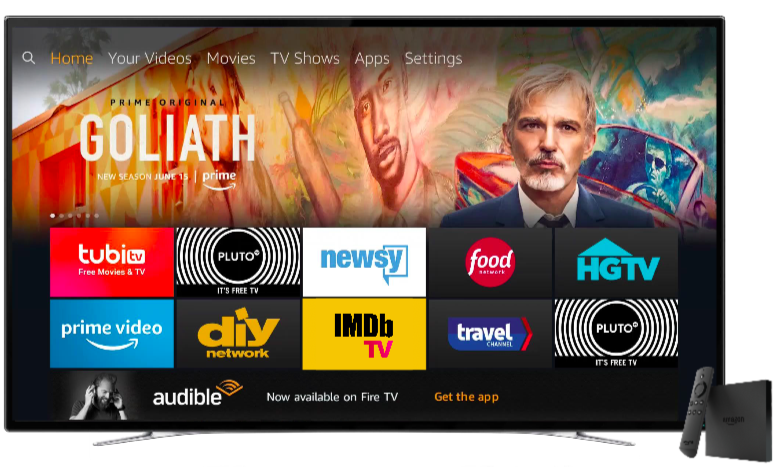Advertisers are maximizing on this billion-dollar industry, following their audience’s eyeballs to over the internet video streaming services with over-the-top video content. So, what exactly does OTT advertising involve? Is it a great promotion strategy for your brand?
Understanding OTT: What does It Mean?
Over-the-top (OTT) advertising is a form of digital marketing that explicitly targets users through audio, video, images, and other data types. OTT ads are delivered directly to devices like computers, smartphones, and tablets. They are different from digital ads, targeted but delivered via search engines or social media platforms.
OTT advertising has become increasingly popular in the United States in recent years. Marketers are drawn to its potential for engaging users more effectively than traditional advertising methods. OTT ads can be customized to target specific demographics, interests, and even locations. They can also be interactive, allowing users to interact with the ad directly or purchase advertised products or services.
OTT is gaining traction pretty fast, especially in the 21st Century as households cut down on their satellite and cable TV subscriptions. The younger generation is leading the migration to streaming video, and more households are expected to cord-cut moving forward. In the United States alone, forecasts show that cord-cutter homes could hit over 46 million by 2024. At this rate, there’s an excellent potential for OTT advertising as brands incorporate streaming ads in their marketing objectives to capture the growing audience.
What is Amazon OTT Advertising?
Amazon OTT advertising is over-the-top media advertising that uses Amazon’s programmatic network, Amazon OTT, and its demand-side platform (DSP) network. If you are part of the changing consumer behavior to the digital streaming media, you’ve probably encountered an OTT.
The advertising technique is becoming more popular not just from the consumer shift but also due to the nature of the programmatic networks. The networks are more sophisticated in audience targeting, precision, and attribution and have high scaling capabilities. These capabilities allow advertisers to achieve television-style advertising formats on streaming media.
Amazon enjoys a vast media network that includes noteworthy platforms like Fire TV, IMDbTV, and Prime Video.
Additionally, Amazon has tens of third-party, ad-supported applications such as Pluto and AMC. All these platforms and apps provide advertisers with great opportunities for reaching millions of audiences via streaming video ads.
Why Should You Advertise via Amazon OTT?
OTT uses a data-driven strategy that delivers advanced audience targeting. Brands do not have to spend time and money like traditional television and OTT, thus a relatively cost-effective advertising solution. Additionally, it allows advertising agencies to tailor ads according to the needs of a particular target audience and explore a performance-based pricing model since OTT ads’ success is measurable. In a more detailed manner, let’s dive into the benefits that Amazon OTT advertising offers.
Better Audience Targeting
Marketing agencies must have large volumes of first-party data to create and connect relevant experienced for ad consumers. With Amazon OTT, advertisers enjoy a 360-degree view of customers provided by the Amazon first-party data platform Amazon Web Services (AWS). AWS offers advertisers insights that help them in audience segmentation, ad targeting, and attribution. They can engage more relevant audiences, which means the ads result in more conversions.
Further, the Amazon DSP helps advertisers understand their target audience based on factors such as:
- Their demographics, which include their age, level of education, disposable income
- Behavioral patterns and interests like shopping patterns and product categories
The Amazon DSP lets you deliver ads that reach new and existing audiences, both on and off the Amazon ecosystem.
In the behavioral audience targeting, Amazon segments the target audience into three categories
- In-market segments that focus on what a client browses or searches on Amazon
- Lifestyle segments focus on broader interest groups, economic, business, or labor interest groups.
- Retarget Amazon shoppers who at some point viewed a product on the platform but are yet to purchase. Such audiences are ideal for retargeting.
In a nutshell, Amazon OTT advertising helps agencies leverage the power of the Amazon first-party data and DSP audience targeting with the effectiveness of the streaming media.
Why Should You Advertise via Amazon OTT?
OTT uses a data-driven strategy that delivers advanced audience targeting. Brands do not have to spend time and money like traditional television and OTT, thus a relatively cost-effective advertising solution. Additionally, it allows advertising agencies to tailor ads according to the needs of a particular target audience and explore a performance-based pricing model since OTT ads’ success is measurable. In a more detailed manner, let’s dive into the benefits that Amazon OTT advertising offers.
Better Audience Targeting
Marketing agencies must have large volumes of first-party data to create and connect relevant experienced for ad consumers. With Amazon OTT, advertisers enjoy a 360-degree view of customers provided by the Amazon first-party data platform Amazon Web Services (AWS). AWS offers advertisers insights that help them in audience segmentation, ad targeting, and attribution. They can engage more relevant audiences, which means the ads result in more conversions.
Further, the Amazon DSP helps advertisers understand their target audience based on factors such as:
- Their demographics, which include their age, level of education, disposable income
- Behavioral patterns and interests like shopping patterns and product categories
The Amazon DSP lets you deliver ads that reach new and existing audiences, both on and off the Amazon ecosystem.
In the behavioral audience targeting, Amazon segments the target audience into three categories
- In-market segments that focus on what a client browses or searches on Amazon
- Lifestyle segments focus on broader interest groups, economic, business, or labor interest groups.
- Retarget Amazon shoppers who at some point viewed a product on the platform but are yet to purchase. Such audiences are ideal for retargeting.

In a nutshell, Amazon OTT advertising helps agencies leverage the power of the Amazon first-party data and DSP audience targeting with the effectiveness of the streaming media.
Genre Blocking
OTT advertising allows you to block your ad from appearing on genres unlikely to result in conversions. For instance, if your product or service falls under the ‘female’ category, you may want to exclude some male-dominated genres. However, the feature is only for US customers and allows them to select five genres for exclusion.
Growing Brands on and off Amazon.
Amazon network hosts both the Amazon-built properties and a host of certified third-party publishers. The publishers enjoy a direct relationship with programmatic buyers on Amazon at zero fees. Brands can grow their earnings using simple cloud integration, and a single contract opens them to unique demand from Amazon and other advertisers.
Therefore, if, for example, you use Amazon’s Fire TV OTT, it means your ad will spread across other numerous applications that Amazon Fire consumers use.
Ad Conquesting
Ad conquesting is a unique feature available for Amazon OTT advertising. It is a technique where your ad hits the screens of potential customers who have viewed products from a competitor’s site. That way, your ad can reach some potential new customers from among your competitor’s audience. The feature is notably exclusive to Amazon OTT advertising.
Ad Expenditure Controls
Amazon Publisher Services (APS) allows for direct integration with OTT applications. Therefore, advertisers can avoid intermediaries and their associated costs. Advertisers can see what they pay for and manage to stick to a strategic budget. Besides, with Amazon OTT ads, advertisers pay depending on the ads’ performance which means they get more value than traditional TV advertising.
According to the Amazon Advertising director of Ad sales, Ryan Mayward, Amazon DSP does not charge the 15% supply-side fee applicable on other DSPs using Amazon Publisher Services. Additionally, there is a Fire TV inventory optimizing policy in which all ad-enabled apps reserve 30% of all their ad impressions for Amazon. That way, you can access more catalogs with the Amazon DSP while maintaining a small scale of expenditure.
How Do You Measure Success With the Amazon OTT?
Performance evaluation is a critical element of every ad campaign, including OTT advertising. Advertisers need to know the audiences they connect with via the OTTs, and how the ads amplify their investments.
Unlike traditional TV ads, where performance measurement largely depends on cable and satellite providers’ analysis, streaming TV ads are more comprehensive. At the same time, it is much easier to track OTT ad campaigns as you can easily get the relevant data.
The success measurement models follow awareness, consideration, and sales metrics which include:
- Brand Reach
The brand reach metrics measure the audience reached scale, which is critical to creating awareness for the brand. Advertisers can measure the brand reach using Digital Ad Ratings (DAR) like Nielsen, which can help determine the OTT ad’s reach, frequency, and overall rating points.
- Brand Lift
The brand lift refers to the impact that the Amazon OTT leaves on your product. Advertisers can measure the brand lift using third-party measurement providers. They will help determine if the OTT ad changes the audiences’ perception about the brand, did they build favor, awareness, or the intent to buy?
- Offline Lift
Offline lifts regard to physical store visits. You can use customers’ visits to your physical stores to measure the performance of an OTT campaign. In this measurement metric, you want to answer questions like how the OTT ad influences client physical store visits or how many physical store visits came from the ad.
- Brand Search
The brand search metric involves measuring the performance of an OTT ad campaign in terms of whether the ad drives increased research and queries about your product and whether it is acquiring new customers.
- Online Visits
Online visits help advertisers to know whether the OTT is driving a higher engagement with the brand. They can use the product detail page views and compare the details before and after the streaming ad.
Getting Started with Amazon OTT
Amazon OTT advertising inventory is accessible via the Amazon DSP, and advertisers can connect directly via the Amazon DSP or through Amazon’s partners who have access to the DSP. Here are the steps we recommend you follow when developing your ad.
- Set clear goals and KPIs for your ad, as they form a critical component of your execution channel.
- Know your audience. Utilize Amazon Audience Solutions and their data-driven strategies to target your audience.
- Execute your OTT ad campaign.
- Actively test, analyze and optimize.
Conclusion
As the paradigm shift to digital media continues to take shape, marketing trends are changing to maximize the emerging media advertising avenues. Amazon OTT advertising sets itself apart as the advertising medium of the future as conventional TV ads slowly lose it. It presents unprecedented power and an audience reach that makes sense to any existing brands that seek to make their products or service visible to the most relevant audience. Advertisers should hurry and join in the early adopters and take advantage of this high-potential and untapped advertising media.
